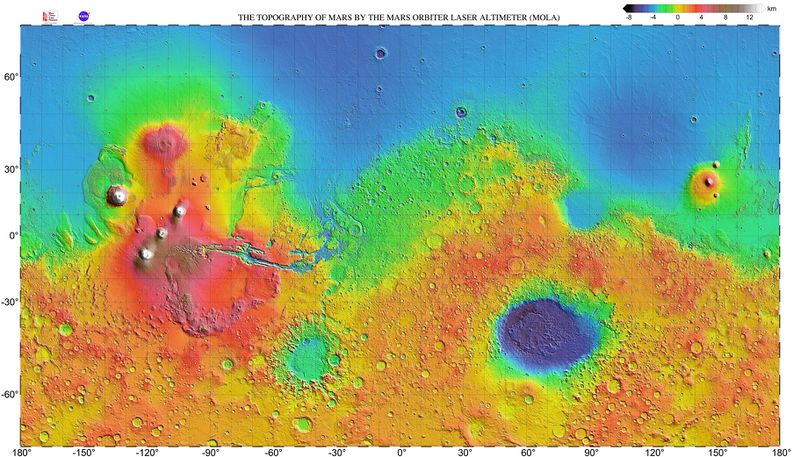Mars atlas Volcanoes and Craters
View a map of:
Volcanoes
Mars today has no active volcanoes. Much of the heat stored inside the planet when it formed has been lost, and the outer crust of Mars is too thick to allow molten rock from deep below to reach the surface. However, Volcanic activity, or volcanism, has played a significant role in the geologic evolution of Mars and it has the largest shield volcanoes in the solar system. Three enormous volcanoes, Ascraeus Mons, Pavonis Mons, and Arsia Mons (collectively known as the Tharsis Montes), sit aligned northeast–southwest along the crest of the bulge. The vast Alba Mons (formerly Alba Patera) occupies the northern part of the region.
Olympus Mons stands 26 kilometers (15.5 miles) above the surrounding plains, and is 500 kilometers (300 miles) wide at its base. It is about two and a half times Mount Everest's height above sea level. It is the largest volcano, the tallest planetary mountain, and the second tallest mountain currently discovered in the Solar System, comparable to Rheasilvia on Vesta. In terms of surface area, Olympus Mons is the second-largest volcano in the solar system, second only to Earth's Tamu Massif. Olympus Mons is the youngest of the large volcanoes on Mars, having formed during Mars's Hesperian Period. It had been known to astronomers since the late 19th century as the albedo feature Nix Olympica (Latin for "Olympic Snow"). Its mountainous nature was suspected well before space probes confirmed its identity as a mountain.
Olympus Mons is located in Mars's western hemisphere at approximately 18.65°N 226.2°E, just off the northwestern edge of the Tharsis bulge. The western portion of the volcano lies in the Amazonis quadrangle (MC-8) and the central and eastern portions in the adjoining Tharsis quadrangle (MC-9).
The western hemisphere of Mars is dominated by a massive volcano-tectonic complex known as the Tharsis region or the Tharsis bulge. This immense, elevated structure is thousands of kilometers in diameter and covers up to 25% of the planet's surface. Averaging 7–10 km above datum (Martian "sea" level), Tharsis contains the highest elevations on the planet. Three enormous volcanoes, Ascraeus Mons, Pavonis Mons, and Arsia Mons (collectively known as the Tharsis Montes), sit aligned northeast–southwest along the crest of the bulge. The vast Alba Mons (formerly Alba Patera) occupies the northern part of the region. The huge shield volcano Olympus Mons lies off the main bulge, at the western edge of the province.
Built up by countless generations of lava flows and ash, the Tharsis bulge contains some of the youngest lava flows on Mars, but the bulge itself is believed to be very ancient. Geologic evidence indicates that most of the mass of Tharsis was in place by the end of the Noachian Period, about 3.7 billion years ago (Gya). Tharsis is so massive that it has placed tremendous stresses on the planet's lithosphere, generating immense extensional fractures (grabens and rift valleys) that extend halfway around the planet. The mass of Tharsis could have even altered the orientation of Mars' rotational axis, causing climate changes
Craters
External links
See also
References
https://www.google.com/mars/ Interactive Map of Mars by Google
https://trek.nasa.gov/mars/ Interactive Map of Mars by NASA. Lots of features.







